PRESTO PLANS
Sent straight to your inbox
CLICK HERE TO ACCESS
Sign up to receive 10 ready-to-use ELA resources your students will love!
10 FREE ELA RESOURCES
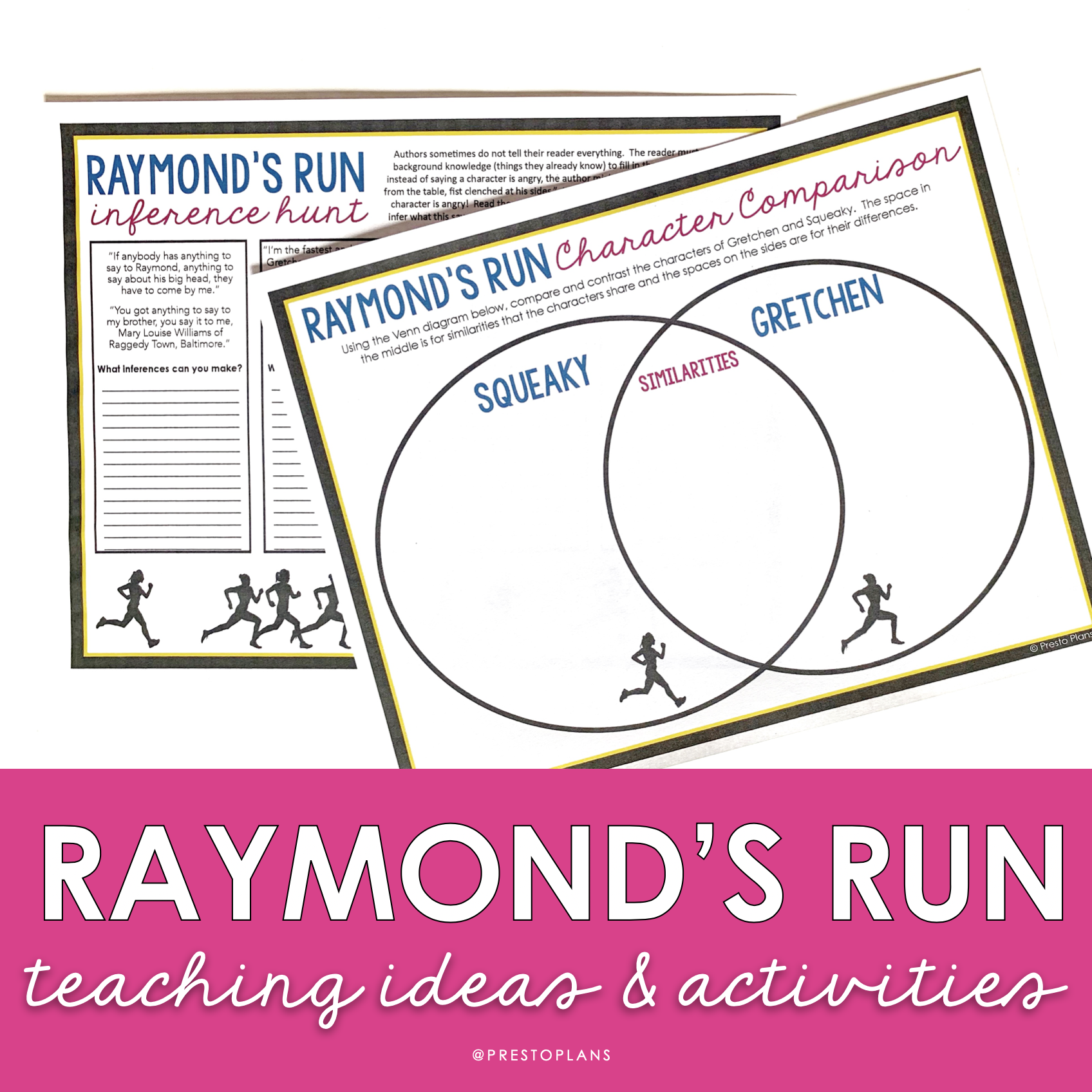
Teaching Raymond’s Run by Toni Cade Bambara
If you are teaching “Raymond’s Run” by Toni Cade Bambara, you may be looking for strategies and tips for analyzing this story. Not to fear as I’m sharing my best tips for helping you navigate all elements of the short story with your students.
Set in the 1950s in Harlem, “Raymond’s Run” follows the story of Hazel Parker, whose nickname is Squeaky, a talented runner who is training for a race alongside her brother, Raymond, who has a disability. Squeaky competes against her rival, Gretchen, and learns more about herself and her brother in the process.
So, where to begin when teaching this compelling short story? Below are some tips to bring this story to life for your middle or high school students.
Build Background Information
Before introducing any short story to your students, I would suggest providing any context that students may need to fully understand the background of the story. I like to focus on three elements of context where appropriate:
- Author
- Historical
- Genre
Introduce students to Toni Cade Bambara with a biographical overview and highlight key moments in her life and career. This gives student a sense of who is telling this story and shows how the author’s life is reflected in the plot line. Bambara, who was born in Harlem in 1939, was an author, filmmaker, professor, and civil rights activist.
You’ll also want to spend some time focussing on the historical context of the story. You can start by telling students that Toni Cade Bambara was born in Harlem near the end of what is known as the Harlem Renaissance. You can explain how during this period, an influx of African-American literature, art, and music celebrated a new cultural identity, as well as how the movement also emphasized the importance of political, social, artistic, and economic freedom for African Americans. Raymond’s Run is set in Harlem, New York.
Finally, provide some background information on the genre (realistic fiction) so that students can keep an eye out for common traits of this genre as they are reading. For example, realistic fiction tells a story that could have actually occurred in a believable setting—in this case, in Harlem. “Raymond’s Run” resembles real life, and the fictional characters within the story react similarly to real people.
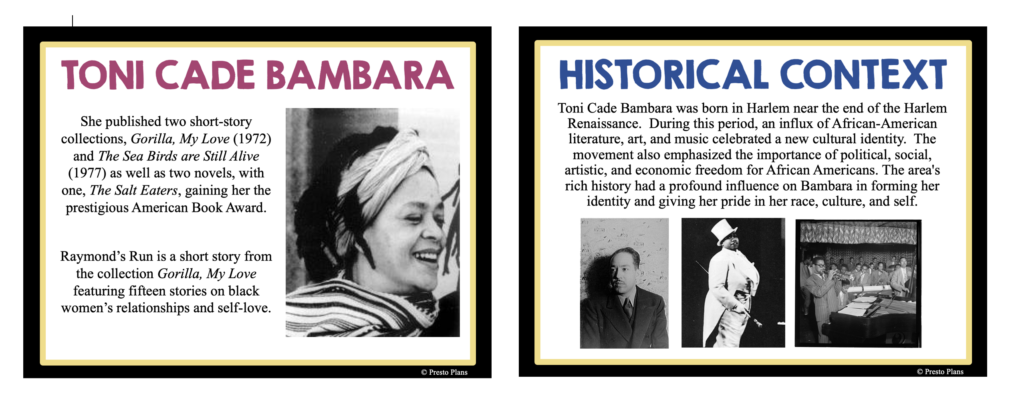
Pre-Reading
Before diving into the story itself, I suggest having students respond to discussion questions so that they can further invest themselves in the story by establishing text-to-self connections and opinions related to the subject matter. I like to use questions related to family and gender stereotypes, which are important themes in the story. I might ask questions like…
- If you have a sibling, are you kind to one another? How do you show each other you care?
- What roles and responsibilities do each of your family members have? What is your role?
- What are some gender stereotypes that still exist today?
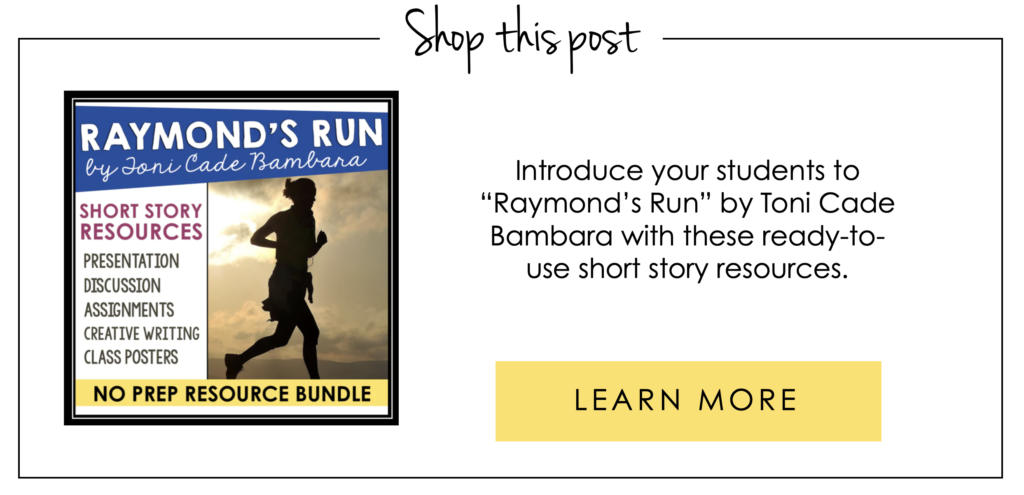
During and Post-Reading
While students are reading, I like to stop from time to time to ensure comprehension. Then, once everyone is done, I like to engage students in post-reading discussion. These discussions allow students to reflect on what they have read and to share their thoughts and ideas with their peers— in small groups and then as a whole class.
There are a few types of questions that work well here. I usually give students an open-ended question that prompts them to reflect on their overall experience with the story and its most important themes, as well as others that prompt them to deepen their text-to-self connections. Here are a couple of examples:
- Did you enjoy the story? Why or why not?
- How does this story relate to the theme of kindness?
R.A.C.E.
Given that the story is about preparing for a race, “Raymond’s Run” lends itself perfectly to introducing the R.A.C.E. constructed response strategy (Restate, Answer, Cite, and Explain) to students. I use this opportunity to break down this acronym and explain how it can be used to develop constructed responses:
- Restate the question: During this part of your response, you will use the question stem to write your topic sentence. This means that you must turn the question asked into a statement.
- Answer the question: After you have restated the question, you must answer ALL parts of the question, keeping in mind that some questions may have more than one part and you may need to separate the question into two responses.
- Cite from the text: Now, you must support your answer by citing evidence from the text. This can be an explanation of an event from the text or specific quotations that support your answer.
- Explain the connection: Finally, you must explain or expand on how the evidence from the text supports your answer. You can also use your own background knowledge here to make connections.
I also give mentor sentences that demonstrate strong examples of each part of the constructed response strategy.
Then, I engage students in a Raymond’s Run text evidence race activity, where students must use their newly acquired knowledge of the R.A.C.E constructed response strategy to answer questions from the story. As shown below, I like to prepare these questions in a creative way that, when connected together, makes it look like Squeaky is running question to question.
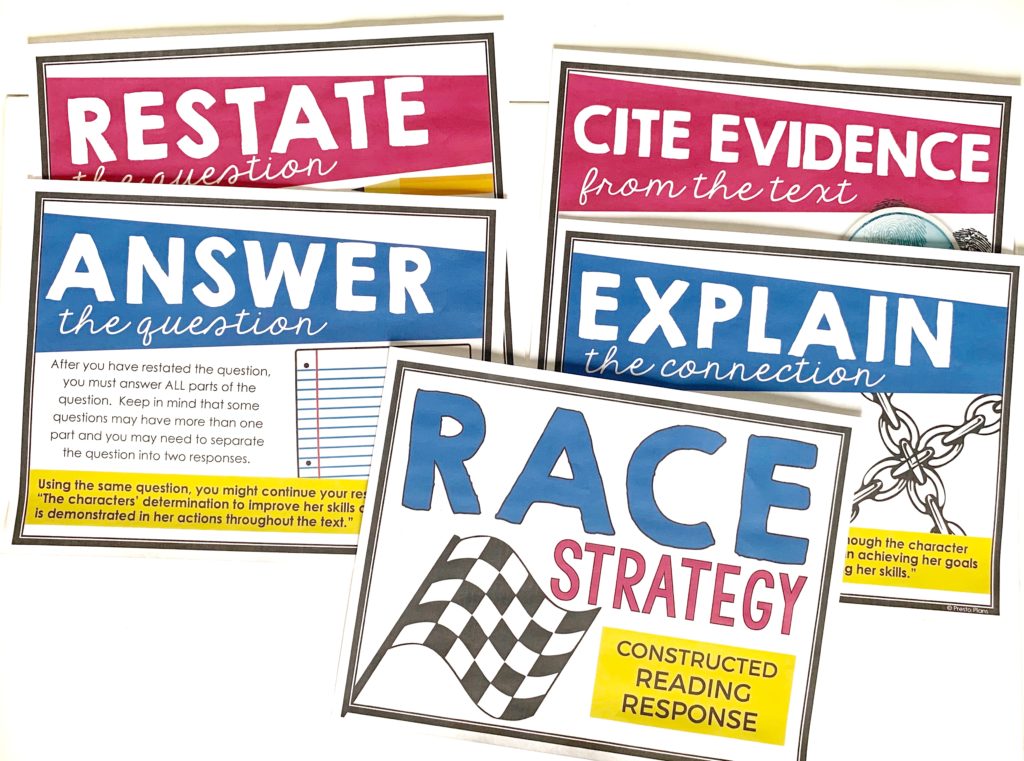
Inference Activity
“Raymond’s Run” often requires the reader to read between the lines when it comes to things like understanding certain key traits of different characters. Therefore, it requires students to use their inference skills. I draw attention to this with an inference hunt activity that has students read quotes from the text and use their background knowledge to infer what they say about Squeaky as a person. For example, I might give them the following quotes:
- “If anybody has anything to say to Raymond, anything to say about his big head, they have to come by me.”
- “You got anything to say to “You got anything to say to my brother, you say it to me, my brother, you say it to me, Mary Louise Williams of Mary Louise Williams of Raggedy Town, Baltimore.”
Using inference, a strong response would explain that these quotes indicate that Squeaky is fiercely protective of her brother. She is also not afraid to get into a verbal or physical altercation with anybody who attempts to say something hurtful to her brother.
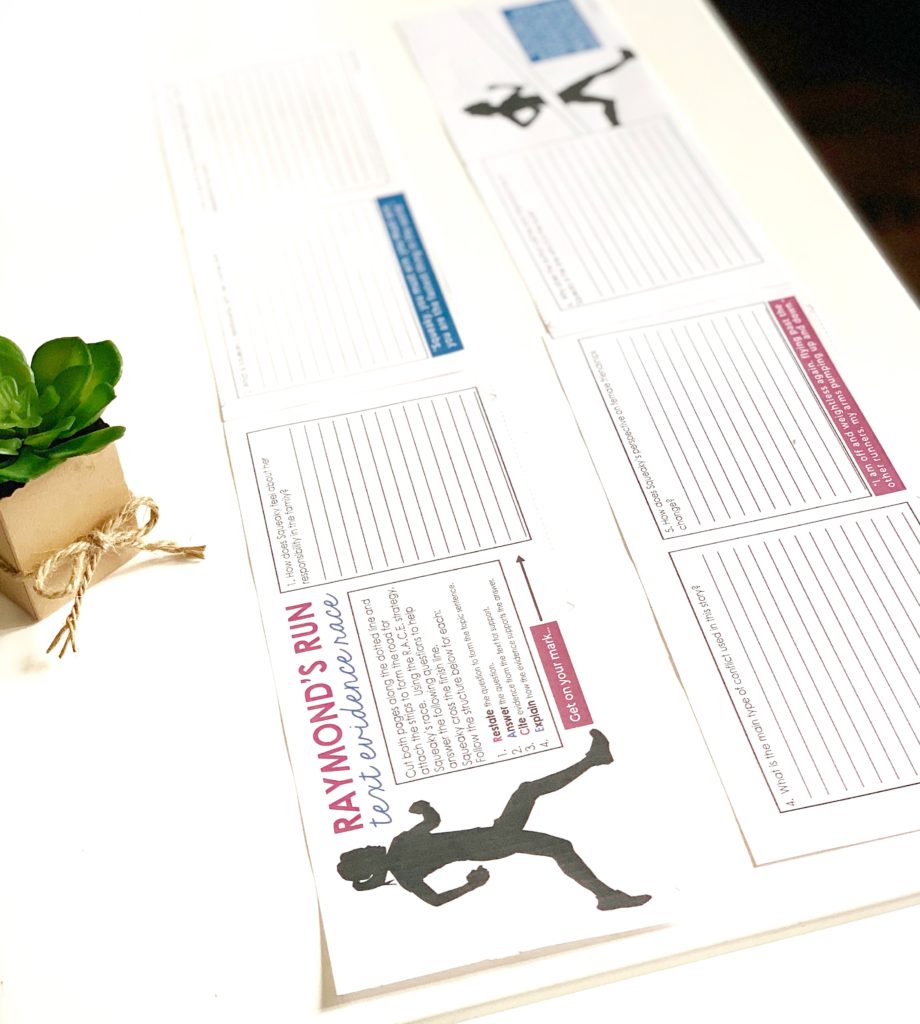
Character Comparison
Another creative activity that I like to use when teaching Raymond’s Run is a character comparison. With this activity, I have students compare and contrast the characters of Squeaky and Gretchen using a Venn diagram. The spaces on the sides are for their differences, and the space in the middle, of course, is for their similarities—of which they have many (i.e. dedication to running, being very driven, respect for each other, etc.).
This activity helps students dive more deeply into Bambara’s use of characterization. It also serves to demonstrate how people you might think you are very different from actually might have more in common with you than you would think.

Analysis Notes
The next thing I like to do when teaching “Raymond’s Run” is guide students through some analysis notes that dive a little deeper into the text. This is where I cover important literary elements like theme, setting, allusion, characterization, etc., and other aspects of the text that they might have missed or deserve closer attention. You can do this as a presentation where you present your own analysis notes to the class. You might also take this opportunity to ask analysis questions for students to complete independently, in small groups, or even as a collaborative activity where they walk around the class and answer questions together printed on chart paper.
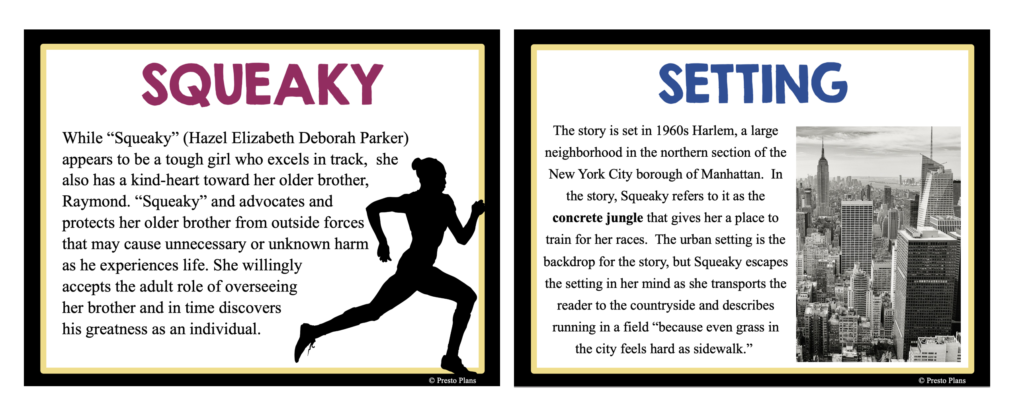
Squeaky’s Speech
The last thing I do when teaching “Raymond’s Run” is engage students in Squeaky’s speech activity, where students have to imagine that Squeaky will give an acceptance speech after she receives her trophy. I get students to write this imaginary speech while trying to mimic her voice. I note that it’s important for them to take into account how Squeaky’s perspective has shifted in the story, and I like to end by getting the students to share their speeches with the class.

Prefer to grab it on TpT? No problem, just click here.
Here is what a few teachers who have used the resources for teaching “Raymond’s Run” already had to say:
- “This is an excellent resource! I used it with my 6th grade class, and it provided rigor and high interest. Thanks so much!” Karen Bristow
- “I used this resource to introduce this short story to my kids! The information and graphics were highly enabling! The activities are better than anything I could have made! This resource is a keeper for many more years to come!” Evan T.
Looking for more stories like this one? Read this blog post with 10 Short Stories to Teach in ELA with Teaching Ideas.
Search the blog for what you are teaching
GIVEAWAYS
sent straight to your inbox!
share this post